
Discover the fascinating Spanish cathedrals that have been declared World Heritage Sites
They always appear on the list of essential visits, and for a good reason. Elegant, grandiose or more simple, all of them are exceptional works of architecture that have earned recognition from UNESCO. Spain is a one-of-a-kind destination, as it can boast being home to numerous World Heritage cathedrals. Come and discover their unique beauty and the amazing collection of styles, artistic gems and secrets they hold.
-
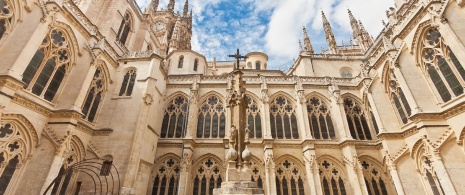
Burgos Cathedral, history of Gothic art
Its slender spiers make up the iconic skyline of Burgos. The construction of the cathedral began in 1221 and ended in 1567, creating the masterpiece of Gothic architecture that we can see today. With its superb architecture and the exceptional art collection it houses, you have a complete compendium of the history of this style, which UNESCO included on its list in 1984. Inside, you will find treasures and curiosities that are well worth a visit. Suffice it to mention just a few, such as the Chapel of the Constables, considered a “cathedral” within the cathedral; the golden staircase, which served as a model for the one in the Paris Opera House; and the Papamoscas or Flycatcher, the unique automaton that strikes the hours and opens its mouth to the rhythm of the bell.
-

Mosque-Cathedral of Córdoba, union of cultures and styles
The Great Mosque of Córdoba was added to the World Heritage List in 1984, a recognition which would later be extended to the historic centre of the city in 1994. Already in its day, this marvel of Moorish architecture aroused general admiration for its size, its decoration and the audacity of its interior height. However, it is a hybrid and contrasting space, a reflection of history, where Christian art and culture are also present. For example, in the immense “forest of columns” you can find elements of the earlier Visigothic building; a Mudejar masterpiece such as the Royal Chapel, or the Renaissance cathedral begun in the 16th century, with its dome, choir chapels and altarpieces. All of this makes up one of the most beautiful and amazing architectural ensembles in the world.
-
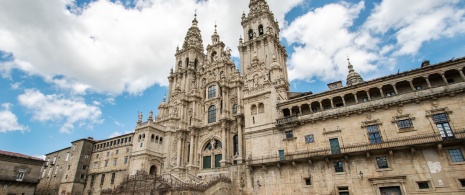
Cathedral of Santiago de Compostela, the destination of the journey
Visiting this famous pilgrimage site is quite an experience. This is the final destination of the different routes of the Camino de Santiago (which have also been declared a World Heritage Site), and it is enveloped in the historic centre of Santiago de Compostela, a UNESCO World Heritage Site since 1985. It is inevitable to feel a sense of admiration for this masterful construction where numerous artistic styles come together. For example, on the Baroque façade facing Obradoiro Square visitors climb a Renaissance staircase to go inside, first passing a masterpiece of Romanesque art, the Portico of Glory.
-
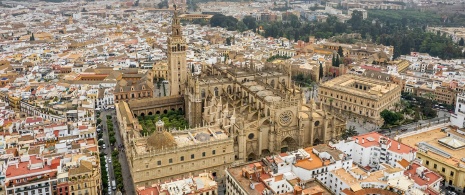
Seville Cathedral, much more than the largest Gothic cathedral in Europe
In the central Plaza del Triunfo are all three monuments of Seville that have been World Heritage Sites since 1987: the cathedral, the Real Alcázar of Seville and the General Archive of the Indies. The ensemble reflects the historical past of the city, with magnificent examples of its stages in history as an Arab, Christian and great metropolis centre of the 16th century. With five naves, the cathedral in Seville is the largest Gothic cathedral in Europe; yet it also stands out for its wealth of architectural and artistic styles. The same is true of its iconic tower, the Giralda, which has a first section in the Almohad style (a Moorish dynasty in Spain) and a Renaissance bell tower. Here you can learn about some of its many curiosities.
-
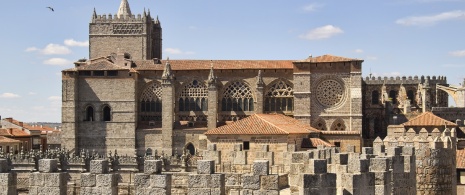
Ávila Cathedral, temple and fortress
In 1985, when UNESCO declared the old city of Ávilaand its churches outside the walls to be a World Heritage Site, it expressly mentioned the Gothic cathedral. Did you know that its apse, called the cimorro, is embedded in the famous wall? In addition to being a unique case of religious and military architecture, it is also considered the first Gothic cathedral in Spain. Its construction, which began in 1172 in a transitional Romanesque style, would become completely Gothic before the end of the century. A striking element is the surprising colour of the “Caleño” or “bleeding” granite, used in the construction of some spaces such as the ambulatory.
-
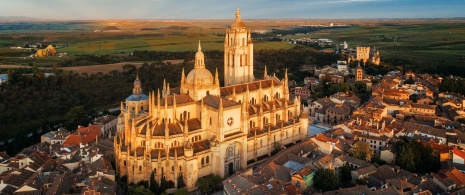
Segovia Cathedral: The “Lady of the Cathedrals”
Its imposing and elegant appearance has earned it the nickname by which it is popularly known. Built between the 16th and 18th centuries, it is one of the latest Gothic cathedrals in Spain and Europe. UNESCO also highlighted this monument when it declared the ensemble of the historical centreand the Aqueduct of Segovia as World Heritage Sites in 1985. Its apse presides over the Plaza Mayor, and its beautiful pinnacles are one of the favourite places for storks to perch at sunset. It has 157 stained glass windows that fill its interior with light, and from its bell tower, reaching 88 metres high, you will have exceptional views of the entire city.
-

Cathedrals in World Heritage Cities
In Spain you will find other destinations such as Toledo, Salamanca, Cuenca, Baeza, San Cristóbal de la Laguna or Eivissa, whose historic centre has been declared a World Heritage Site. When you visit them, you will discover their cathedrals to be one of their most outstanding attractions. Also in the city of Oviedo, inside its Cathedral of San Salvador you will find the Holy Chamber, which was recognised by UNESCO for being a representative work of pre-Romanesque art from Asturias.
-

Cathedrals of the Mudejar architecture of Aragon
Mudejar art appeared in Aragón around the 12th century. Some time later, this artistic legacy unique in the world would be included on the World Heritage list. In 1986, UNESCO recognised one of its greatest masterpieces in the Cathedral of Santa María de Mediavilla in Teruel, made up of the tower, the dome and its roof, considered the “Sistine Chapel of the Mudejar style”. The designation would also be extended to other buildings in 2001, such as La Seo de Zaragoza, for its dome and the façade of the Parroquieta or “little parish”.













